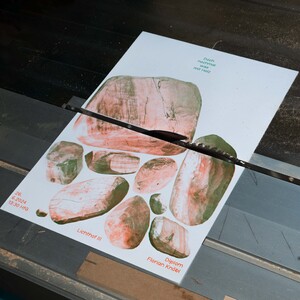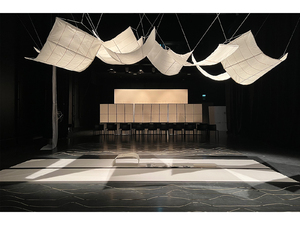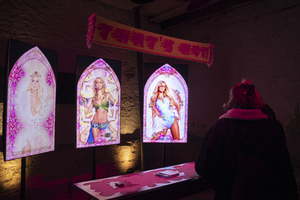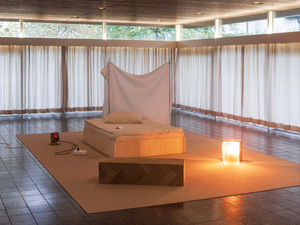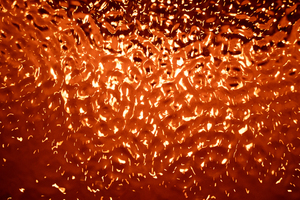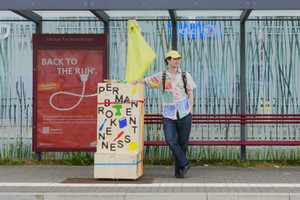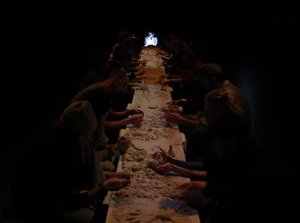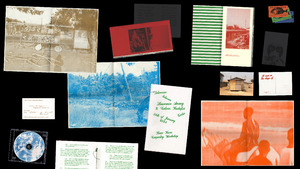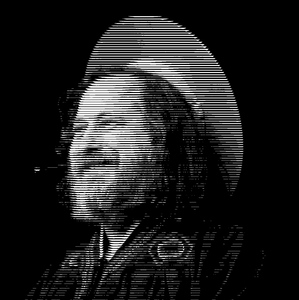Abschlussarbeiten-Archiv
Benachbarte Sets (16)Alle Zusammenhänge anzeigen
Diese Sets wurden den gleichen Sets hinzugefügt wie das ausgewählte Set.
16 Inhalte
- Seite 1 von 2
Doch nochmal was mit Holz
- Titel
- Doch nochmal was mit Holz
- Autor/in
- Beschreibung (de)
- In meinem Diplom „Doch nochmal was mit Holz“ werden ausschließlich Holzreste von abgestorbenen Bäumen und solchen, die industriell keine Verwendung bekommen können transformiert. Äste werden jetzt zu ziegelartigen Holzsteinen, andere Teile des Baumes zu Natursteinen oder Geröll.
Ergänzt wird diese Holzwelt durch übergroße Nägel aus hochgebranntem Ton, die geschmiedete Metallnägel, verrostet und neu, nachahmen.
- In meinem Diplom „Doch nochmal was mit Holz“ werden ausschließlich Holzreste von abgestorbenen Bäumen und solchen, die industriell keine Verwendung bekommen können transformiert. Äste werden jetzt zu ziegelartigen Holzsteinen, andere Teile des Baumes zu Natursteinen oder Geröll.
- Beschreibung (en)
- In my diploma “Doch nochmal was mit Holz”, only wood residues from dead trees and those that cannot be used industrially are transformed. Branches now become brick-like wooden stones, other parts of the tree become natural stones or boulders.
This world of wood is complemented by oversized nails made of high-fired clay that imitate forged metal nails, rusted and new.
- In my diploma “Doch nochmal was mit Holz”, only wood residues from dead trees and those that cannot be used industrially are transformed. Branches now become brick-like wooden stones, other parts of the tree become natural stones or boulders.
- Kategorie
- Schlagworte
- Dank an
- Material
- Ort: Institution
- Ort
- Lichthof 3
- Stadt
- Land
- Beteiligte Institution(en)
- Titel
- Doch nochmal was mit Holz
- Projektleiter/in
- Semester
- Studiengang
- Typ der Abschlussarbeit
- Importiert am
- 06.10.2024
- Übergeordnete Sets
- 0
- Set enthält
- 0 14
Die Inseln
- Titel
- Die Inseln
- Titel (en)
- The Island
- Autor/in
- Beschreibung (de)
- Meine Arbeit zielt darauf ab, die Gefühle der heutigen chinesischen Jugend zu verstehen. Teure Wohnungen und stressige Jobs machen das Leben schwierig, besonders in überfüllten Städten, wo kaum Freizeit bleibt. Viele Menschen sehnen sich nach einem Ort der Entspannung, einem
Zufluchtsort fernab vom Trubel des Stadtlebens.
Nehmen wir meinen Freund als Beispiel. Um innere Ruhe zu finden, hat er seine kleine Wohnung mit grünen Pflanzen gefüllt. Obwohl der Raum nicht groß ist, ist er seine kleine Oase. Inspiriert von einem koreanischen Gedicht über die Suche nach Trost inmitten der Menschenmengen, glaube ich, dass wir alle einen besonderen Ort brauchen – eine ruhige "Insel" inmitten des Trubels.
Wie finden wir diese innere Insel? Ich denke, das ist für jeden unterschiedlich. Vielleicht durch das Genießen von Kunst oder das Teilnehmen an einer ruhigen Teezeremonie. Für mich ist es das Drachenbauen. Das Drachenbauen ist eine kollektive Erfahrung, die Freude und Frieden bringt, ähnlich wie das Finden unseres eigenen ruhigen "Drachenwegs".
Mein Abschlussprojekt soll Menschen helfen, ihre eigene Friedensinsel zu entdecken. Ich habe einen Raum geschaffen, in dem Besucher diese Reise selbst erleben können. Wenn man eintritt, fühlt es sich an, als würde man meine Insel betreten. Das Design ist von der Ästhetik und Philosophie der chinesischen Song-Dynastie inspiriert, bekannt für ihre tiefe Verbindung zur Natur und Poesie.
In diesem Raum finden Sie eine Mischung aus realen und virtuellen Elementen – Pflanzen, Steine, Vögel und Wasser – all diese Elemente verschmelzen, um eine friedliche Umgebung zu schaffen.
Im Wesentlichen ist mein Kunstwerk sowohl ein Spiegelbild der menschlichen Suche nach innerem Frieden als auch eine Feier dieser Suche. Durch Kunst, Performance und den Kontakt mit der Natur hoffe ich, andere zu inspirieren, ihre eigene ruhige Insel inmitten des Lebenssturms zu finden.
- Meine Arbeit zielt darauf ab, die Gefühle der heutigen chinesischen Jugend zu verstehen. Teure Wohnungen und stressige Jobs machen das Leben schwierig, besonders in überfüllten Städten, wo kaum Freizeit bleibt. Viele Menschen sehnen sich nach einem Ort der Entspannung, einem
- Beschreibung (en)
- My work aims to understand the feelings of today’s Chinese youth. Expensive apartments and stressful jobs make life challenging, especially in crowded cities where there’s little time for relaxation. Many people long for a place of peace, a sanctuary far from the hustle and bustle of city life.
Take my friend, for example. To find inner calm, he filled his small apartment with green plants. Although the space isn’t large, it has become his little oasis. Inspired by a Korean poem about seeking comfort amidst the crowds, I believe we all need a special place – a quiet “island” amid the chaos.
How do we find this inner island? I think it’s different for everyone. Perhaps it’s enjoying art or participating in a quiet tea ceremony. For me, it’s kite-making. Kite-making is a collective experience that brings joy and peace, much like finding our own serene “kite path.”
My final project is meant to help people discover their own island of peace. I created a space where visitors can experience this journey themselves. When you enter, it feels as if you’re stepping onto my island. The design is inspired by the aesthetics and philosophy of the Chinese Song Dynasty, known for its deep connection to nature and poetry.
In this space, you’ll find a blend of real and virtual elements – plants, stones, birds, and water – all merging to create a peaceful environment.
Essentially, my artwork is both a reflection of the human search for inner peace and a celebration of this quest. Through art, performance, and connection with nature, I hope to inspire others to find their own quiet island amid the storm of life.
- My work aims to understand the feelings of today’s Chinese youth. Expensive apartments and stressful jobs make life challenging, especially in crowded cities where there’s little time for relaxation. Many people long for a place of peace, a sanctuary far from the hustle and bustle of city life.
- Kategorie
- Schlagworte
- Titel
- Die Inseln
- Projektleiter/in
- Semester
- Studiengang
- Typ der Abschlussarbeit
- Importiert am
- 14.11.2024
- Übergeordnete Sets
- 0
- Set enthält
- 0 7
WHERE LEGENDS ARE MADE AND LIES ARE TOLD
- Titel
- WHERE LEGENDS ARE MADE AND LIES ARE TOLD
- Autor/in
- Beschreibung (de)
- WHERE LEGENDS ARE MADE AND LIES ARE TOLD (graduation project). Originated by this divine union of @parishilton @britneyspears @lindsaylohan (aka the Holy Trinity <3) the night of the infamous Bimbo Summit, WLAMALAT is the visual and critical translation of my obsession for the #y2k it-girls and #popculture in general. Mixing a religious with a highly commercial aesthetic, the project questions several topics such as women representation in the mass media, visual/celebrity culture consumption and new belief systems.
- WHERE LEGENDS ARE MADE AND LIES ARE TOLD (graduation project). Originated by this divine union of @parishilton @britneyspears @lindsaylohan (aka the Holy Trinity <3) the night of the infamous Bimbo Summit, WLAMALAT is the visual and critical translation of my obsession for the #y2k it-girls and #popculture in general. Mixing a religious with a highly commercial aesthetic, the project questions several topics such as women representation in the mass media, visual/celebrity culture consumption and new belief systems.
- Beschreibung (en)
- WHERE LEGENDS ARE MADE AND LIES ARE TOLD (graduation project). Originated by this divine union of @parishilton @britneyspears @lindsaylohan (aka the Holy Trinity <3) the night of the infamous Bimbo Summit, WLAMALAT is the visual and critical translation of my obsession for the #y2k it-girls and #popculture in general. Mixing a religious with a highly commercial aesthetic, the project questions several topics such as women representation in the mass media, visual/celebrity culture consumption and new belief systems.
- WHERE LEGENDS ARE MADE AND LIES ARE TOLD (graduation project). Originated by this divine union of @parishilton @britneyspears @lindsaylohan (aka the Holy Trinity <3) the night of the infamous Bimbo Summit, WLAMALAT is the visual and critical translation of my obsession for the #y2k it-girls and #popculture in general. Mixing a religious with a highly commercial aesthetic, the project questions several topics such as women representation in the mass media, visual/celebrity culture consumption and new belief systems.
- Kategorie
- Typ des Projekts/Werks
- Datierung
- 06.12.23
- Dank an
- Ort
- Rudolf 5
- Titel
- WHERE LEGENDS ARE MADE AND LIES ARE TOLD
- Projektleiter/in
- Semester
- Studiengang
- Typ der Abschlussarbeit
- Importiert am
- 05.11.2024
- Übergeordnete Sets
- 0
- Set enthält
- 3 8
Letters of Dissent
- Titel
- Letters of Dissent
- Titel (en)
- Letters of Dissent
- Autor/in
- Beschreibung (de)
- Mein Diplomprojekt mit dem Titel „LETTERS OF DISSENT“ hatte zum Ziel, praktische und zugängliche Mittel des nächtlichen Protests zu erforschen. Dieses Projekt, das sich mit der Wechselbeziehung von Geschichtenerzählen und Punk-Einflüssen befasst, soll durch künstlerische Intervention ein Schlaglicht auf soziale und politische Themen werfen. Es handelt sich um selbst geschriebene Erzählungen, die in einer auf optimale Lesbarkeit ausgelegten Schriftart verfasst sind. Die Einfachheit der verwendeten Technik sorgt für Tragbarkeit und Zugänglichkeit. Das Engagement der Gemeinschaft ist integraler Bestandteil des Werks, das sowohl als Lasercut- als auch als 3D-Druckversion vorliegt und als Open-Source-Initiative zur Verfügung gestellt wird. Die Gesamtästhetik ist von auffallender Helligkeit geprägt und schafft eine visuell beeindruckende und deutlich wahrnehmbare Präsenz. Neben der Hauptdiplomarbeit ist es erforderlich, neuere Arbeiten in einer Ausstellung zu präsentieren, in der sorgfältig ausgewählte Projekte vorgestellt werden. In dem Bemühen, das Ausstellungsdesign auf das übergreifende Thema des Diplomprojekts abzustimmen, zielte der Designansatz darauf ab, wesentliche Prinzipien wie Zugänglichkeit, Abfallminimierung und eine ephemere Pop-up-Sensibilität zu verkörpern.
- Beschreibung (en)
- My diploma project titled "LETTERS OF DISSENT," aimed to explore practical and approachable means of protesting during the nighttime. Delving into the interrelation of storytelling and punk influence, this project seeks to cast a spotlight on social and political subjects through artistic intervention. It involves self-written narratives, utilising a font designed for optimal readability. The simplicity of the technique employed ensures portability and accessibility. Community engagement is integral, using both a lasercut and 3D-print version of the work, which is made available as an open-source initiative. The overall aesthetic is marked by striking brightness, creating a visually impactful and overtly noticeable presence. In addition to the primary diploma project, it is required to showcase recent works in an exhibition, featuring carefully chosen projects. In an effort to align the exhibition design with the overarching theme of the diploma project, the design approach aimed to encapsulate essential principles such as accessibility, waste minimisation, and an ephemeral, pop-up sensibility.
- Kategorie
- Schlagworte
- Datierung
- 03.11.2023
- Titel
- Letters of Dissent
- Projektleiter/in
- Semester
- Studiengang
- Typ der Abschlussarbeit
- Importiert am
- 30.10.2024
- Übergeordnete Sets
- 0
- Set enthält
- 1 12
Anything Besides a Bed
- Titel
- Anything Besides a Bed
- Autor/in
- Beschreibung (de)
- "Anything Besides a Bed" ist eine Kollektion bestehend aus sechs Arbeiten, die sich alle mit bestimmten Aspekten des Betts befassen: Schlafgewohnheiten, Dunkelheit und künstliches Licht, Lesen in und Reden über Betten, deren technologisches und digitales Umfeld sowie Privatsphäre, Intimität und Öffentlichkeit.
Jedes einzelne Objekt entsteht durch Beobachten, Vermischen, Austauschen und Kombinieren seiner kulturhistorischen, archäologischen, philosophischen oder sozialen Kontexte, gleichzeitig aber auch die Kontexte und formalen Aspekte der tatsächlichen Gegenstände, die im Umfeld eines Betts herum zu finden sind.
Daraus ergeben sich sechs Objekte, die nicht nur einfach eine Recherche und Analyse wiedergeben, sondern durch gewisse Interventionen in ihrer Form und Funktionsweise als nutzbares Möbel bzw. technisches Gerät zum Nachdenken anregen.
- "Anything Besides a Bed" ist eine Kollektion bestehend aus sechs Arbeiten, die sich alle mit bestimmten Aspekten des Betts befassen: Schlafgewohnheiten, Dunkelheit und künstliches Licht, Lesen in und Reden über Betten, deren technologisches und digitales Umfeld sowie Privatsphäre, Intimität und Öffentlichkeit.
- Beschreibung (en)
- "Anything Besides a Bed" is a collection consisting of six objects that all deal with certain aspects of the bed: sleep patterns, darkness and artificial light, reading and talking about beds, technological and digital environment as well as privacy and publicity.
Every individual object is conceived by observing, mixing, interchanging, and combining its contexts. These being the research aspects as well as the contexts of being actual objects and pieces of furniture that are found around the bed. The objects don’t just reflect their research but have their own purpose by being thought-provoking interventions in the way they look and are used.
- "Anything Besides a Bed" is a collection consisting of six objects that all deal with certain aspects of the bed: sleep patterns, darkness and artificial light, reading and talking about beds, technological and digital environment as well as privacy and publicity.
- Kategorie
- Typ des Projekts/Werks
- Schlagworte
- Datierung
- October 2023
- Dank an
- Moritz Appich
- Francesca Audretsch
- Massimiliano Audretsch
- Tim Bartel
- Vincent Carl Becher
- Nils Bergmann
- Jonathan Blaschke
- Sibylle Bläser
- Christoph Bläser
- Vanessa Bosch
- Oliver Boualam
- Richard Brunner
- Jules Buchholtz
- Felipe Carrión
- Sam Chermayeff
- Lukas Clark
- Céline Condorelli
- Ute Deutz
- Lizzy Ellbrück
- Lisa Ertel
- Marie Faaß
- Hanna Franke
- Taavi Hallimäe
- Teresa-Louise Häußler
- Susanne Heyer
- Matthias Holznagel
- Bruno Jacoby
- Chris Kabel
- Tobias Keilbach
- Barbara Zoé Kiolbassa
- Florian Knöbl
- Mio Kojima
- Julian Kuf
- Stefan Legner
- Lukas Marstaller
- Mona Mayer
- Isabel Motz
- Anne-Sophie Oberkrome
- Vlado Petrovic
- Barbara Polakova
- Johanna Schäfer
- Susanne Schmitt
- Waldemar Schwab
- Moritz Kamil Simon
- Wieki Somers
- Lorenz Stein
- Marcel Strauß
- Saskia van der Meer
- Leia Morgana Walz
- Jannis Zell
- Phil Zumbruch
- Sprache
- Material
- Abmessungen
- Mattress Multiplug Maße: 240 × 130 × 75 mm, Street Light Lamp Maße: 330 × 330 × 350 mm, Bedspread Curtain Maße: 2300 × 1800 mm / 350 × 350 × 1800 mm, Parquet Chest Maße: 1200 × 400 × 300 mm, Bedside Readings Maße: 109 × 75 × 108 mm, Sleep Timer Maße: 220 × 220 × 240 mm
- Ort: Institution
- Ort
- ZKM Pavillon
- Stadt
- Land
- Beteiligte Institution(en)
- Titel
- Anything Besides a Bed
- Projektleiter/in
- Semester
- Studiengang
- Typ der Abschlussarbeit
- Importiert am
- 05.11.2024
- Übergeordnete Sets
- 0
- Set enthält
- 0 7
Wave Talk
- Titel
- Wave Talk
- Autor/in
- Beschreibung (de)
- Die Arbeit "Wave Talk" umfasst eine interaktive Kunstinstallation mit drei Objekten, die sich mit der tiefen philosophischen Frage der Selbsterkenntnis und der wechselseitigen Beziehung zwischen Individuum und Umwelt beschäftigt. Hinterfragt wird die Idee der Identität und Realität: Wie nehmen wir uns selbst wahr und wie wird diese Wahrnehmung durch unsere Umgebung, Handlungen und Worte verändert? Alle Objekte arbeiten mit der Darstellung von Sound (Kymatik). Die Frequenzen setzen das Material in Bewegung und verändern den Ist-Zustand. Die Installation lädt so den Betrachter ein zum Staunen, Besinnen, Meditieren und Erkennen, dass das Selbst nicht statisch, sondern dynamisch ist – ständig im Wandel, geformt und verzerrt durch äußere Einflüsse. Diese Verzerrungen spiegeln wider, wie unser Selbstbild und unsere Realität durch soziale, emotionale und körperliche Resonanzen beeinflusst werden. "Wave Talk" vermittelt die Idee, dass unsere Interaktionen mit der Umwelt eine ständige, nicht verbale Kommunikation darstellen – eine Art stiller Dialog, der die Veränderlichkeit und Sensibilität unserer Wahrnehmung symbolisiert.
Die Objekte:
1. Spiegel: Selbstreflexion und Resonanz
Ein runder Spiegel, der durch einen Näherungssensor und einen Körperschallwandler sanft zu vibrieren beginnt, wenn der Betrachter sich nähert. Die feine Vibration symbolisiert die subtile Resonanz zwischen Mensch und Umgebung und die fragile, fließende Natur der Selbstwahrnehmung – das Selbstbild verändert sich ständig im Austausch mit der Umwelt.
2. Wasserschale: Stimme und Resonanz
Ein kleineres Becken, dessen Wasser durch die Stimme des Betrachters in Schwingung gerät. Die Schwingungen stehen für die Kraft des inneren Ausdrucks, der sich im Außen manifestiert. Worte und Gedanken erzeugen Resonanzen, die sowohl die physische als auch die soziale Welt prägen – in jeder Schwingung offenbart sich die Tiefe des Moments.
3. Wasserbecken (120 cm Durchmesser): Berührung und Schwingung
Ein großes Becken, das auf Berührung reagiert und Wellen über die Wasseroberfläche schickt. Jede Berührung setzt Resonanzen frei, die sich ausbreiten und die Umgebung beeinflussen. Das Objekt verdeutlicht, dass selbst kleinste Handlungen Spuren in der Welt hinterlassen – ein stilles Gespräch zwischen uns und der Unendlichkeit.
- Die Arbeit "Wave Talk" umfasst eine interaktive Kunstinstallation mit drei Objekten, die sich mit der tiefen philosophischen Frage der Selbsterkenntnis und der wechselseitigen Beziehung zwischen Individuum und Umwelt beschäftigt. Hinterfragt wird die Idee der Identität und Realität: Wie nehmen wir uns selbst wahr und wie wird diese Wahrnehmung durch unsere Umgebung, Handlungen und Worte verändert? Alle Objekte arbeiten mit der Darstellung von Sound (Kymatik). Die Frequenzen setzen das Material in Bewegung und verändern den Ist-Zustand. Die Installation lädt so den Betrachter ein zum Staunen, Besinnen, Meditieren und Erkennen, dass das Selbst nicht statisch, sondern dynamisch ist – ständig im Wandel, geformt und verzerrt durch äußere Einflüsse. Diese Verzerrungen spiegeln wider, wie unser Selbstbild und unsere Realität durch soziale, emotionale und körperliche Resonanzen beeinflusst werden. "Wave Talk" vermittelt die Idee, dass unsere Interaktionen mit der Umwelt eine ständige, nicht verbale Kommunikation darstellen – eine Art stiller Dialog, der die Veränderlichkeit und Sensibilität unserer Wahrnehmung symbolisiert.
- Beschreibung (en)
- The work ‘Wave Talk’ comprises an interactive art installation with three objects that deals with the deep philosophical question of self-knowledge and the reciprocal relationship between the individual and the environment. It scrutinises the idea of identity and reality: how do we perceive ourselves, and how is this perception changed by our surroundings, actions, and words? All objects work with the representation of sound (cymatics). The frequencies set the material in motion and change the actual state. The installation thus invites the viewer to marvel, reflect, meditate, and recognise that the self is not static but dynamic—constantly changing, shaped, and distorted by external influences. These distortions reflect how our self-image and our reality are influenced by social, emotional, and physical resonances. ‘Wave Talk’ conveys the idea that our interactions with the environment are a constant, non-verbal communication—a kind of silent dialogue that symbolises the mutability and sensitivity of our perception.
The objects:
1. Mirror: Self-Reflection and Resonance
A round mirror that begins to vibrate gently when the viewer approaches, triggered by a proximity sensor and a tactile transducer. This subtle vibration symbolises the delicate resonance between human and environment, highlighting the fragile, fluid nature of self-perception—constantly shifting in interaction with the world.
2. Small Water Basin: Voice and Resonance
A smaller basin where the water is set in motion by the viewer's voice. The ripples represent the power of inner expression manifesting in the outer world. Words and thoughts create resonances that shape both the physical and social realms—in every vibration, the depth of the moment is revealed.
3. Large Water Basin (120 cm diameter): Touch and Vibration
A large basin that responds to touch by sending waves across the water’s surface. Every touch releases resonances that ripple outward, impacting the surroundings. This piece illustrates that even the smallest actions leave traces in the world—a silent conversation between us and infinity.
- The work ‘Wave Talk’ comprises an interactive art installation with three objects that deals with the deep philosophical question of self-knowledge and the reciprocal relationship between the individual and the environment. It scrutinises the idea of identity and reality: how do we perceive ourselves, and how is this perception changed by our surroundings, actions, and words? All objects work with the representation of sound (cymatics). The frequencies set the material in motion and change the actual state. The installation thus invites the viewer to marvel, reflect, meditate, and recognise that the self is not static but dynamic—constantly changing, shaped, and distorted by external influences. These distortions reflect how our self-image and our reality are influenced by social, emotional, and physical resonances. ‘Wave Talk’ conveys the idea that our interactions with the environment are a constant, non-verbal communication—a kind of silent dialogue that symbolises the mutability and sensitivity of our perception.
- Kategorie
- Typ des Projekts/Werks
- Schlagworte
- Datierung
- 24.10.2024
- Titel
- Wave Talk
- Projektleiter/in
- Semester
- Studiengang
- Typ der Abschlussarbeit
- Importiert am
- 03.11.2024
- Übergeordnete Sets
- 0
- Set enthält
- 0 34
PERMANENT BROKENNESS
- Titel
- PERMANENT BROKENNESS
- Autor/in
- Beschreibung (de)
- PERMANENT BROKENNESS ist eine mobile (Infra-)Struktur, die das transformative Potential von öffentlichen Orten aufzeigt, indem sie die Reparatur von Haushalts- und Konsumgeräten verfügbar und sichtbar macht. Angelehnt an das Format des Reparatur-Cafés, werden Benutzer*innen dazu eingeladen eigenständig und gemeinsam Dinge zu reparieren. Hierbei steht nicht nur die Müllvermeidung und Ressourcenschonung im Vordergrund, sondern vor allem der selbstwirksame Zugang zur dinglichen Umwelt. Das Projekt basiert auf einer umfangreichen Recherche zur kulturellen Praxis des Reparierens und formuliert ein Gegennarrativ zu Hegemonien der Produktion, der Innovation und des unreflektierten Massenkonsums.
- Beschreibung (en)
- PERMANENT BROKENNESS is a mobile (infra-)structure that demonstrates the transformative potential of public spaces by making the repair of household and consumer appliances available and visible. Inspired by the repair café format, users are invited to repair things independently and together. The focus here is not only on avoiding waste and conserving resources, but above all on self-effective access to the material environment. The project is based on extensive research into the cultural practice of repairing and formulates a counter-narrative to hegemonies of production, innovation and unreflected mass consumption.
- Kategorie
- Schlagworte
- Datierung
- 26.06.2024
- Mitwirkende
- Dank an
- Titel
- PERMANENT BROKENNESS
- Projektleiter/in
- Semester
- Studiengang
- Typ der Abschlussarbeit
- Importiert am
- 01.11.2024
- Übergeordnete Sets
- 0
- Set enthält
- 0 6
Etwas Aufnehmen
- Titel
- Etwas Aufnehmen
- Titel (en)
- Get in touch with
- Untertitel
- Eine Reading Performance in 4 Teilen
- Untertitel des Projekts/Werks (en)
- A reading performance in 4 chapters
- Autor/in
- Beschreibung (de)
- "Etwas Aufnehmen" ist eine 30-minütige interaktive Reading-Performance über den (Tast-)sinn. Sie findet an einem 15 m langen Steintisch statt, 80 kg kinetischer Sand liegen auf ihm verteilt. Die Performance entstand in sechsmonatiger Recherche und im Austausch mit einer blinden Künstlerin, einem Tastforscher, einem Übersetzer von visuellen Lernmaterialien und einer Tierkommunikationsexpertin, und erzählt außerdem von einer Kollaboration mit einem Hund (Betty). Welcher Stellenwert nimmt der Tastsinn in unserer Wahrnehmung ein, um Dinge wortwörtlich zu “begreifen”? Wie kommuniziere oder gestalte ich mit einem Tier, welches auf ganz andere Sinne zurückgreifen kann? "Etwas Aufnehmen" hinterfragt die eigene Wahrnehmung und beschreibt den Drang nach Verständigung. Die Reading Performance ist sowohl taktil, auditiv als auch visuell wahrnehmbar.
- Beschreibung (en)
- ‘Get in touch with’ is a 30-minute interactive reading performance about the (tactile) sense. It takes place on a 15 metre long stone table with 80 kg of kinetic sand on top. The performance is the result of a six-month research and exchange with a blind artist, a tactile researcher, a translator of visual learning materials and an animal communication expert, and also tells of a collaboration with a dog (Betty). What role does the sense of touch play in our perception? How do I communicate or design with an animal that has access to completely different senses? ‘Etwas Aufnehmen’ questions our own perception and describes the urge for understanding. The reading performance can be experienced tactilely, acoustically and visually.
- Kategorie
- Typ des Projekts/Werks
- Schlagworte
- Datierung
- Februar 2023
- Mitwirkende
- Dank an
- Sprache
- Untertitel (Film)
- Material
- Abmessungen
- Länge: 15m, Breite: 25cm, Höhe: 25cm
- Dauer
- 30min
- Ort: Institution
- Ort
- Großes Studio
- Stadt
- Land
- Internetlinks
- Titel
- Etwas Aufnehmen
- Projektleiter/in
- Semester
- Studiengang
- Typ der Abschlussarbeit
- Lehrveranstaltung
- Importiert am
- 05.10.2024
- Übergeordnete Sets
- 0
- Set enthält
- 0 16
block to blob
- Titel
- block to blob
- Titel (en)
- block to blob
- Untertitel
- tracing back materiality
- Untertitel des Projekts/Werks (en)
- tracing back materiality
- Autor/in
- Beschreibung (de)
- block to blob
This diploma project details the material stream of synthetic plastics through a reverse chronological approach. It combines field research, visual documentation, and material experimentation to retrace the journey of plastics from their final products back to their origins in petroleum.
‘block to blob’ includes visits to various sites in the production chain, such as manufacturing facilities, oil refineries, pipelines, and extraction sites, concluding in a forest ecosystem, where crude oil naturally seeps to the earth's surface. These experiences are compiled into a research publication that follows this reverse narrative.
A video installation documents the visited locations, providing visual context for the industrial processes, hidden infrastructure and the natural substance in the forest. Additionally, a series of objects made from petroleum-coated wood and polystyrene grounds the project in tangible materials.
- block to blob
- Beschreibung (en)
- This diploma project details the material stream of synthetic plastics through a reverse chronological approach. It combines field research, visual documentation, and material experimentation to retrace the journey of plastics from their final products back to their origins in petroleum.
‘block to blob’ includes visits to various sites in the production chain, such as manufacturing facilities, oil refineries, pipelines, and extraction sites, concluding in a forest ecosystem, where crude oil naturally seeps to the earth's surface. These experiences are compiled into a research publication that follows this reverse narrative.
A video installation documents the visited locations, providing visual context for the industrial processes, hidden infrastructure and the natural substance in the forest. Additionally, a series of objects made from petroleum-coated wood and polystyrene grounds the project in tangible materials.
- This diploma project details the material stream of synthetic plastics through a reverse chronological approach. It combines field research, visual documentation, and material experimentation to retrace the journey of plastics from their final products back to their origins in petroleum.
- Kategorie
- Typ des Projekts/Werks
- Schlagworte
- Datierung
- 2024
- Sprache
- Untertitel (Film)
- Material
- Technik/Verfahren/Formate
- Pine wood coated with petroleum, Wood soaked in gasoline and pressed/bonded with polystyrene
- Abmessungen
- L x B x H mm, Petroleum-coated wooden objects: Bench: 800 x 200 x 450, 2x T-Stool: 350 x 200 x 450, Stool (3-legged): 450 x 270 x 450, Stool (wide): 600 x 450 x 450, TV stand: - Polystyrene Objekts: Counter: 500 x 370 x 1100, 2x Bench1: 1000 x 570 x 400, Bench2: 1300 x 570 x 350, Stool: 500 x 370 x 570
- Dauer
- 1.: upstream 0 - oil seeping naturally to the surface - Alsace - 2:55min, 2.: upstream 1 - prospect drilling for oil reservoirs - Weingarten - 2:17min, 3.: upstream 2 - horse head pumps extracting oil - Landau - 3:50min, 4.: midstream - transalpine pipeline - Triest-Karlsruhe - 10:40min, 5.: downstream 1 - germany biggest oil refinery - Karlsruhe - 3:13min, 6.: downstream 2 - world biggest chemical plant - Ludwigshafen - 2:19min
- Ort: Institution
- Ort
- Lichthof 3
- Stadt
- Land
- Titel
- block to blob
- Projektleiter/in
- Semester
- Studiengang
- Typ der Abschlussarbeit
- Lehrveranstaltung
- Importiert am
- 03.11.2024
- Übergeordnete Sets
- 0
- Set enthält
- 0 0
A man in the shape of...
- Titel
- A man in the shape of...
- Titel (en)
- A man in the shape of...
- Autor/in
- Beschreibung (de)
- „A man in the shape of...“ ist eine von Calvin Kudufia realisierte Ausstellung, die Februar 2024 im Rahmen seines Diploms stattfand. In der Ausstellung beschäftigt sich Kudufia mit der metaphorischen Praxis des Sammelns und Verdichtens: „gathering time and binding it“, wie es die dänische Dichterin Inger Christensen in ihrem Gedicht „Alphabet“ (1981) formuliert hat. Scheinbar unzusammenhängende ‚Dinge‘ werden im Gedicht zusammengetragen und durch die einfache Verwendung eines einzelnen Wortes, des "Existierens" in Zusammenhang gebracht und bedeutsam gemacht. Allein die Geste des Zusammentragen und Benennens verstärkt ihre symbolische Kraft.
Durch einen losen Kontaktpunkt in 2019 begann Kudufias Recherche an der Sepulkralkultur der fantasy coffins, einem traditionellen Kunsthandwerk der Ga-Ethnie in Ghana. Die individuell gestalteten Särge folgen einem mündlich überlieferten Bildindex und sind stellvertretende Gefäße für das ins Jenseits übertretende Leben. Die ‚fantasy coffins‘ verhüllen nicht nur den physischen Körper, ihre Hülle trägt konkrete Spuren der in ihnen gefassten Existenz.
Wie alle Gefäße schirmen die ‚fantasy coffins‘ ihren Inhalt vor den Blicken der Umgebung ab. Im selben Moment dienen sie als repräsentativer Körper des Verstorbenen. Die Suche nach dem richtig geformten Gefäß, sei es ein Weidenkorb für Früchte, ein Buch für Worte oder im Fall der ‚fantasy coffins‘ ein Fischernetz für Fischer, stellt die Suche nach Signifikanz des eigenen Lebens dar: eine treffende Metapher für die Odyssee des Lebens.
In seiner Arbeit „A man in the shape of...“ macht Kudufia sein väterliches Haus in Tema (Ghana) zum physischen Ausgangspunkt seiner Recherche. In Form einer trans-medialen Erzählung wird dessen Essenz eingefangen und greifbar gemacht. Poetische Artefakte und Beobachtungen aus dem Alltag in Ghana werden sorgfältig arrangiert und dienen als Verdinglichung von Zeit. Sie dienen als greifbare Säulen von Kudufias Zeit in Ghana.
„A man in the shape of...“ trägt der angeborenen Sehnsucht nach einer konkreten geografischen Verankerung Rechnung. Kudufia nutzt die gesamte Ausstellung als metaphorischen Fingerzeig auf einen Ort auf der Landkarte.
In Form einer Audioübertragung, einer speziellen Sitzposition auf der Nachbildung eines traditionellen Hockers, referentiellen Bautechniken und einer Dreikanal-Videoinstallation wird diese geografische Verankerung konkret vermittelt. Durch die Untersuchung der Rolle von Ritualen bei der Gestaltung unseres Zugehörigkeitsgefühls, inspiriert durch die philosophischen Überlegungen von Byung Chul Han, bietet die Ausstellung ein Fenster zu einer Kultur, die gleichzeitig vertraut und fremd ist.
Im Mittelpunkt der Ausstellung steht eine Videoinstallation, die in sieben Abschnitte unterteilt ist. Die Aufteilung bezieht sich auf die Tradition der „one-week observation“ und beschreibt jeweils eine Facette von Kudufias persönlicher Reise. Das Video wird begleitet von einem Musikstück der ghanaischen Theatermacherin Edufa T. Sutherland, das mit der Unterstützung des Cellisten Ben Grocock gespielt und aufgenommen wurde. Das Video lässt Kudufias Erinnerungen, Fiktionen und Realitäten verschwimmen und vermischt dabei die Identitäten von Kudufia mit denen seines Vaters und Großvaters und lässt so ein komplexes Netz aus Zugehörigkeiten entstehen.
Eine Publikation, die integraler Bestandteil der Ausstellung ist, bedient sich der Form eines Gefäßes. Eine bedruckte Archivbox sammelt Kudufias Spuren auf seiner Suche nach den ‚fantasy coffins‘ und wird durch eine Hand voll ephemeraler Druckprodukte und Publikationen zum Dokumentationsapparat. Im Mittelpunkt der Archivbox steht ein Interview, zwischen Kudufia und dem Sargmacher Lawrence Anang in dessen Werkstatt in Teshie. Die einzige textliche Spur, die eine klare Verbindung zur Geschichte der Särge herstellt.
Das hölzerne Fundament einer nachgebauten Hütte dient als Sammelpunkt der Ausstellung und ermöglicht die Verbindung zwischen Druckerzeugnissen, Audio, Artefakten und den Betrachtenden. Die Kombination aus gesammeltem haptischen Material und audiovisuellen Arbeiten setzt sich zu einer transmedialen Collage zusammen, in der Kudufia die Geschichte seiner Verwurzelung auf intime Weise erzählt.
- „A man in the shape of...“ ist eine von Calvin Kudufia realisierte Ausstellung, die Februar 2024 im Rahmen seines Diploms stattfand. In der Ausstellung beschäftigt sich Kudufia mit der metaphorischen Praxis des Sammelns und Verdichtens: „gathering time and binding it“, wie es die dänische Dichterin Inger Christensen in ihrem Gedicht „Alphabet“ (1981) formuliert hat. Scheinbar unzusammenhängende ‚Dinge‘ werden im Gedicht zusammengetragen und durch die einfache Verwendung eines einzelnen Wortes, des "Existierens" in Zusammenhang gebracht und bedeutsam gemacht. Allein die Geste des Zusammentragen und Benennens verstärkt ihre symbolische Kraft.
- Beschreibung (en)
- "A man in the shape of..." is an exhibition realised by Calvin Kudufia, which took place in February 2024 as part of his diploma. In the exhibition, Kudufia deals with the metaphorical practice of "gathering time and binding it", as formulated by the Danish poet Inger Christensen. Through a trans-medial narration, the exhibition aims to capture the essence of his father's home in Tema (Ghana) and to make it tangible by carefully compiling poetic artefacts from the observed everyday life in Ghana.
Kudufia's research began with the so-called fantasy coffins, a traditional handicraft practiced by the Ga people of Ghana. The individually designed coffins follow an oral figurative index and are emblematic vessels for life passing into the afterlife. Not only do they conceal the physical body, but their shell bears imprints of the existence that preceded death. To give an example, the vessel of a fisherman might take the form of a boat or fishing net.
Similar to all vessels, they shield their content from its surroundings, simultaneously serving as a representation of the deceased to the eyes of the outside world. The search for the right-shaped vessel, be it a wicker basket for fruit or a book for words, mirrors the journey to discover one's own significance, as displayed figuratively by the fantasy coffins - an apt metaphor for the odyssey of life.
"A man in the shape of..." takes into account the innate longing for a concrete geographical rooting and uses the entirety of the exhibition as a metaphorical finger pointing to a place on the map. This geographical pinning is conveyed in the form of an audio transmission, a special seating position on a replica of a traditional stool, referential construction techniques and a three-channel video installation. By examining the role of rituals in shaping our sense of belonging, inspired by the philosophical reflections of Byung Chul Han, the exhibition offers a window into a culture that is both familiar and foreign at the same time.
At the heart of the exhibition is a video installation divided into seven segments referring to the tradition of the one-week observation, each describing a facet of Kudufia's personal journey. The video installation is accompanied by a musical piece composed by Edufa T. Sutherland, played and recorded with the assistance of cellist Ben Grocock. It blurs the boundaries between memory, fiction, and reality, inviting the viewer to reflect on the complexity of cultural identity and belonging.
The publication, an integral part of the exhibition, also takes the form of a vessel. Borrowing the shape of a printed archive box it collects Kudufia's traces on his search for the fantasy coffins and is conveyed through his graphic expression. At its center is an interview he conducted with coffin maker Lawrence Anang in his workshop in Teshie, the sole textual trace of the coffins' history.
In order to bring all of the pieces together, a wooden fundament of a hut serves as the gathering point of the exhibition, enabling the connection between printed matter, audio, artefacts, and the viewers.
The collected haptic material combined with the audiovisual pieces results in a trans-medial collage in which Kudufia intimately tells the story of his rooting.
- "A man in the shape of..." is an exhibition realised by Calvin Kudufia, which took place in February 2024 as part of his diploma. In the exhibition, Kudufia deals with the metaphorical practice of "gathering time and binding it", as formulated by the Danish poet Inger Christensen. Through a trans-medial narration, the exhibition aims to capture the essence of his father's home in Tema (Ghana) and to make it tangible by carefully compiling poetic artefacts from the observed everyday life in Ghana.
- Kategorie
- Typ des Projekts/Werks
- Schlagworte
- Datierung
- 22.02.2024
- Dank an
- Sprache
- Material
- Ort: Institution
- Ort
- Lichthof 04
- Stadt
- Land
- Titel
- A man in the shape of...
- Projektleiter/in
- Semester
- Studiengang
- Typ der Abschlussarbeit
- Importiert am
- 31.05.2024
- Übergeordnete Sets
- 0
- Set enthält
- 0 21
I Cried A Smile
- Titel
- I Cried A Smile
- Autor/in
- Beschreibung (de)
- Mit den Mitteln einer wissenschaftlichen Lecture erzählt „I Cried A Smile“ eine Geschichte über eine Person mit 2 Köpfen, Holz das zu Menschen wird, und die Erinnerung daran als Kind mit Neuropsychologie in Kontakt zu treten. Zwei übereinander hängende Projektionsflächen zeigen Zeichnungen, Animationen und gefundenes Bildmaterial während meine Stimme vom Band läuft und ich an einem Schreibtisch sitzend, mit dem Verfahren „Lip-Sync“ lautlos mitspreche. Das Publikum sitzt wie in einem anatomischen Theater in zwei Halbkreisen um mich herum.
- Beschreibung (en)
- Using the means of a scientific lecture, “I Cried A Smile” tells a story about a person with two heads, wood that becomes human, and the memory of coming into contact with neuropsychology as a child. Two projection screens hanging above me showcasing drawings, animations and found footage while my voice runs from the tape and I, sitting at a desk, speak along inaudibly using the “Lip-Sync” method. The audience sits around me like in an anatomical theater.
- Using the means of a scientific lecture, “I Cried A Smile” tells a story about a person with two heads, wood that becomes human, and the memory of coming into contact with neuropsychology as a child. Two projection screens hanging above me showcasing drawings, animations and found footage while my voice runs from the tape and I, sitting at a desk, speak along inaudibly using the “Lip-Sync” method. The audience sits around me like in an anatomical theater.
- Kategorie
- Typ des Projekts/Werks
- Schlagworte
- Mitwirkende
- Technik/Verfahren/Formate
- 2 Channel Video
- Dauer
- 8 Minuten
- Ort: Institution
- Stadt
- Land
- Titel
- I Cried A Smile
- Importiert am
- 30.09.2024
- Übergeordnete Sets
- 0
- Set enthält
- 0 5
Who cares?
- Titel
- Who cares?
- Titel (en)
- Who Cares?
- Untertitel
- Digitale Sozialität, Infrastrukturen der Fürsorge und konviviale Technologien
- Untertitel des Projekts/Werks (en)
- Digital sociality, care infrastructure and convivial technology
- Autor/in
- Beschreibung (de)
- Hacker culture connects theory and praxis (following hand-on principles) and a new approach to culture materials (»information wants to be free«), that implies not only a different epistemology, but also a new political discourse on digitality, devices, and people. The relation between technic and politic of this group is analyzed in the first chapter: first focusing on the emergence of proprietary software; then considering the differences between open source and free software, the last one challenging radically the notion of private property and the social relation among programs, users, and developers. Later on, reading Hanna Arendts "The Human condition", the relation will be further discussed in terms of labor, work and action, necessity and freedom, which establish the conditions for politics. In the second chapter, the concept of conviviality (Ivan Illich) is introduced and discussed. This idea is later developed in maintenance as infrastructural care and proposed as a central element of digital technologies that should be further discussed. This constellation of thinking and acting, playing and learning, experimenting and taking responsibility, as well as politics and social relations should play a prominent role in the debate about technology.
- Beschreibung (en)
- Die Hackerkultur verbindet Theorie und Praxis (nach hand-on Prinzipien) und einen neuen Ansatz für Kulturmaterialien (»information wants to be free«), der nicht nur eine andere Epistemologie, sondern auch einen neuen politischen Diskurs über Digitalität, Geräte und Menschen impliziert. Das Verhältnis zwischen Technik und Politik dieser Gruppe wird im ersten Kapitel analysiert: Zuerst wird die Entstehung proprietärer Software betrachtet, dann die Unterschiede zwischen Open Source und freier Software, und wie im letzten die Privateigentum und die soziale Beziehung zwischen Programmen, Benutzern und Entwicklern radikal in Frage gestellt werden. Später wird diese Beziehung anhand von Hanna Arendts _Die conditio humana_ in Bezug auf Arbeit, Herstellen und Handlen, Notwendigkeit und Freiheit, die die Bedingungen für Politik schaffen, weiter diskutiert. Im zweiten Kapitel wird das Konzept der Konvivialität (Ivan Illich) vorgestellt und diskutiert. Diese Idee wird später in der Wartung als infrastrukturelle Vorsorge weiterentwickelt und als ein zentrales Element digitaler Technologien vorgeschlagen, das weiter diskutiert werden sollte. Diese Konstellation des Denkens und Handelns, des Spielens und Lernens, des Experimentierens und der Übernahme von Verantwortung sowie der Politik und der sozialen Beziehungen sollte in der Technologiedebatte eine wichtige Rolle spielen.
- Kategorie
- Typ des Projekts/Werks
- Schlagworte
- Datierung
- 30.03.2023
- Sprache
- Titel
- Who cares?
- Projektleiter/in
- Semester
- Studiengang
- Typ der Abschlussarbeit
- Importiert am
- 30.11.2023
- Übergeordnete Sets
- 0
- Set enthält
- 0 4
